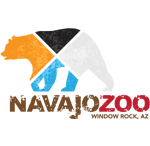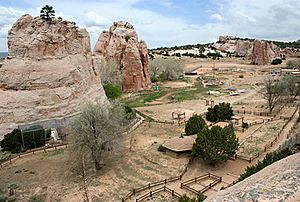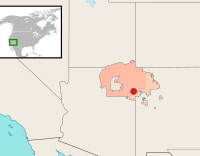Navajo Nation Zoological and Botanical Park facts for kids
 |
|

Zoo grounds
|
|
| Date opened | 1963 |
|---|---|
| Location | Window Rock, Navajo Nation (Arizona), United States |
| Land area | 14.7 acres (5.9 ha) |
| Coordinates | 35°39′51.12″N 109°3′4.32″W / 35.6642000°N 109.0512000°W |
| No. of animals | ~100 |
| No. of species | 50 |
| Annual visitors | ~ 45,000 |
The Navajo Nation Zoological and Botanical Park is a special place in Window Rock, Arizona. This town is the capital of the Navajo Nation. What makes this zoo unique? It's the only zoo in the United States owned by a Native American tribe!
You'll notice something cool here: the animal signs are in both English and Navajo. This helps keep the Navajo language alive. The zoo started in the early 1960s. It became part of the Navajo Nation Department of Fish and Wildlife in 2006.
This zoo has a special job. It helps protect animals and plants important to Navajo culture. It's a place where nature and tradition come together.
Contents
The zoo's first animal was a bear! It was left behind after the 1963 Navajo Nation Fair. People named the bear "Yogi" after a popular cartoon character. From that start, the zoo grew.
Today, it has about 50 different kinds of animals. Most of these animals are native to the area. In 1976, the zoo moved to its current spot. It was first called the "Navajo Tribal Zoo." Later, it joined the Navajo Nation Department of Fish and Wildlife. This happened in September 2006.
Who Works at the Zoo and How Is It Funded?
The zoo has a director and curator named David Mikesic. He is a biologist. He used to work with endangered animals for the Navajo Nation. The zoo also has five full-time staff members. These staff members take care of the animals every day. They also help build and fix things at the zoo. They even create fun activities for the animals.
The Navajo Nation Government provides most of the zoo's money. The zoo also asks for donations. People can help by sponsoring projects or "adopting" an animal. It's free to visit the zoo!
What Animals Can You See at the Zoo?
The zoo covers about 14.7 acres of land. It's close to the Navajo Nation Museum in Window Rock. About 100 animals live here. They represent over 50 different species. Around 45,000 people visit the zoo each year.
The zoo calls itself "a Sanctuary for Nature and the Spirit." Its main goal is to protect native plants and animals. This includes rare and endangered species. They focus on animals and plants important to Navajo culture. Most animals at the zoo were injured or orphaned. Some were rescued from illegal pet owners. They can't survive in the wild on their own.
Animals at the Zoo
You can see many wild creatures here. These include black bears, bobcats, Mexican wolves, mule deer, and elk. You might also spot Gila monsters, coyotes, cougars, and red foxes.
The zoo also has birds like wild turkeys, cranes, golden eagles, red-tailed hawks, and great horned owls. The zoo has had the endangered Mexican wolf since the 1980s. In 2015, the zoo moved its snakes to new homes. This was done out of respect for cultural beliefs. The zoo also became home to the endangered black-footed ferret.
None of the zoo's birds were caught to be put on display. They were rescued after getting hurt. For example, they might have been hit by cars or power lines. Because of their injuries, they can't fly or live in the wild.
Discovery Center and Zoo Improvements
In 2008, the zoo updated its Discovery Center. It now meets modern zoo standards. This center shows many of the park's invertebrates (animals without backbones). It also shares traditional Navajo stories about animals.
The zoo has made many improvements in recent years. For the animals, they added permanent shades. They also made the coyote and elk enclosures bigger. They built a special area for sick animals. A large aviary (bird enclosure) for eagles was also built.
For visitors, the zoo added more signs. They paved the parking lot and built concrete sidewalks. There are more places to sit. They also built a covered stage for events. A large pavilion was added for parties.
Adopt an Animal Program
You can "adopt" any animal at the zoo! It costs $150 each year. This money helps pay for the animal's food and care. When you adopt, you get a certificate. Your name will also be put on a plaque next to the animal's exhibit.
If an animal has never been adopted, you can even give it a name! For example, the mountain lion was named "Hunter." The elk was named "Boomer." One of the golden eagles was named "Thor."
Golden Eagle Sanctuary
Since 2008, the zoo worked hard to get money and permission to build an eagle sanctuary. This sanctuary has a very important purpose. It allows the zoo to give eagle feathers to Navajo tribal members. This follows federal law.
Normally, if an eagle dies, the federal government collects its remains. They send them to a special place in Colorado. Native American people then have to apply to get feathers. This process can take many years.
But a tribal-operated eagle sanctuary is different. It's an exception to the rule. This helps the Navajo Nation keep its cultural traditions strong. In 2012, the U.S. Fish and Wildlife Service allowed the Navajo Nation to give naturally molted eagle feathers to its members. These feathers came from the four golden eagles already at the zoo.
In 2015, the Navajo Nation Zoo got the money needed for a large [Eagle Sanctuary]. The Navajo Nation Council, the Navajo Nation Department of Tourism, and the U.S. Fish and Wildlife Service helped a lot. Many other groups also helped make this project happen.
The Navajo Nation Golden Eagle Sanctuary officially opened on July 1, 2016. It started with 5 golden eagles that couldn't be released into the wild. By 2018, it housed 10 golden eagles. The sanctuary is very big, about 80 feet long and 50 feet wide. It has many places for the eagles to perch. It can hold up to 25 golden eagles.
This sanctuary is a permanent home for eagles that can't live in the wild. It's also a place to see golden eagles and learn about them. Most importantly, it's a legal source of molted feathers for Navajo and other Native American people.
See also
 In Spanish: Parque botánico y zoológico de la Nación Navajo para niños
In Spanish: Parque botánico y zoológico de la Nación Navajo para niños


